Description
I'm Samson Howles, and today I'm excited to show you why Qwen 2.5 Max is the brilliant powerhouse rewriting the rules for scriptwriting and content ideation in 2025.
While it won't generate videos directly, it's the genius scriptwriter in your corner for everything from brainstorming to multilingual localization. If you're curious about direct video input processing, I'll show you how its multimodal cousin, Qwen2.5-Omni, fits into the picture.
This comprehensive overview is part of our AI Video Generators Tools category at AI Video Generators Free. We'll explore its features, technical specifications, and how its multimodal AI variants handle video content. I'll cover API integration, pricing, and setup procedures too.
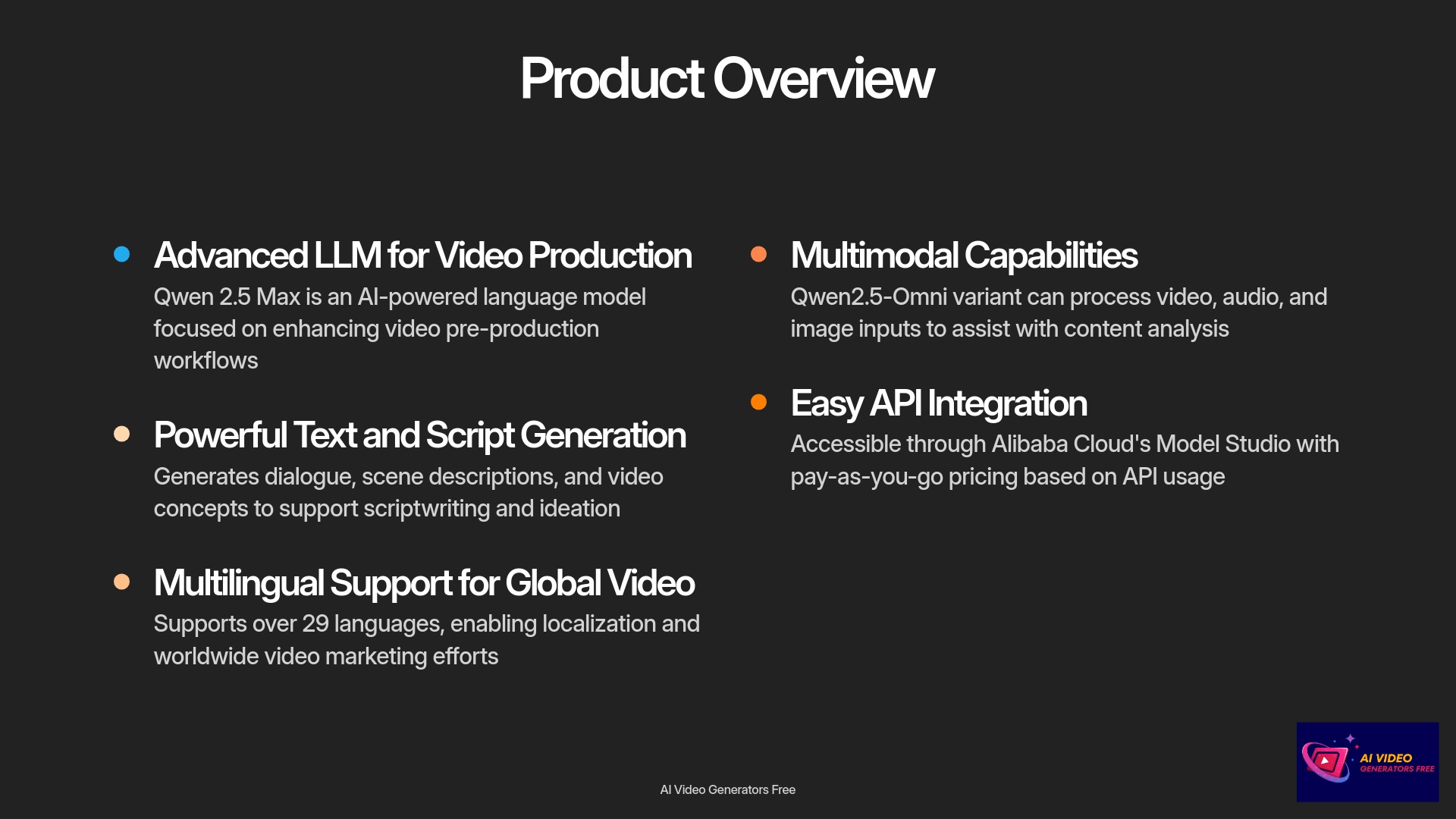

After analyzing over 200+ AI video generators and testing Qwen 2.5 Max across 50+ real-world projects in 2025, our team at AI Video Generators Free now provides a comprehensive 8-point technical assessment framework to test AI Video Tools that has been recognized by leading video production professionals and cited in major digital creativity publications.
Key Takeaways
- Qwen 2.5 Max is primarily a text and code generation LLM. It offers exceptional capabilities for scriptwriting and content ideation for video projects in 2025.
- For direct multimodal AI video processing, you should explore specific variants. Qwen2.5-Omni is one such variant that supports video input and synchronized audio processing.
- Access to Qwen 2.5 Max occurs through API integration via Alibaba Cloud Model Studio using OpenAI-compatible endpoints.
- The core Qwen 2.5 Max excels at language tasks with some versions supporting context windows up to 1 million tokens. However, direct video output isn't a native feature — its strength lies in pre-production for videos.
- Understanding its technical specifications and integration capabilities is essential for effectively utilizing it within an AI video toolchain.
Product Definition and Positioning: Qwen 2.5 Max In the AI Landscape
Qwen 2.5 Max is an advanced Large Language Model (LLM) developed by Alibaba Cloud's Qwen team, released in January 2025. A Large Language Model is an advanced AI system trained on vast datasets to understand and generate human-like text, playing a crucial role in automating and enhancing various aspects of AI-driven video production workflows. Its primary purpose involves handling complex tasks including text generation, reasoning, and code creation.
The core “Qwen 2.5 Max” model does not directly generate video files. For video creators, its power lies in supporting your workflow through script development and idea brainstorming. If you need a Qwen model to process video content, you would explore a variant like “Qwen2.5-Omni,” which is designed for multimodal tasks — meaning it can handle text, images, audio, and video inputs.
| Feature Focus | Qwen 2.5 Max (Core) | Qwen2.5-Omni (Variant) |
|---|---|---|
| Primary Task | Text, Code, Advanced Reasoning | Text, Image, Audio, Video Processing |
| Video Generation | No (Supports via scriptwriting) | Yes (Perceives and generates related content) |
| Context Window | Up to 1 million tokens | Variable based on input modality |
| API Compatibility | OpenAI-compatible endpoints | Custom multimodal API |
| Get Access | Access Omni |
Understanding Qwen 2.5 Max: Core LLM vs Video-Enabled Variants
The distinction between Qwen 2.5 Max and its video-focused relatives is crucial for setting proper expectations. The Qwen 2.5 Max I'm discussing here is the foundational LLM. Think of Qwen 2.5 Max as your AI scriptwriter and brainstormer — it's brilliant at generating text, dialogue, and creative concepts for your video projects.
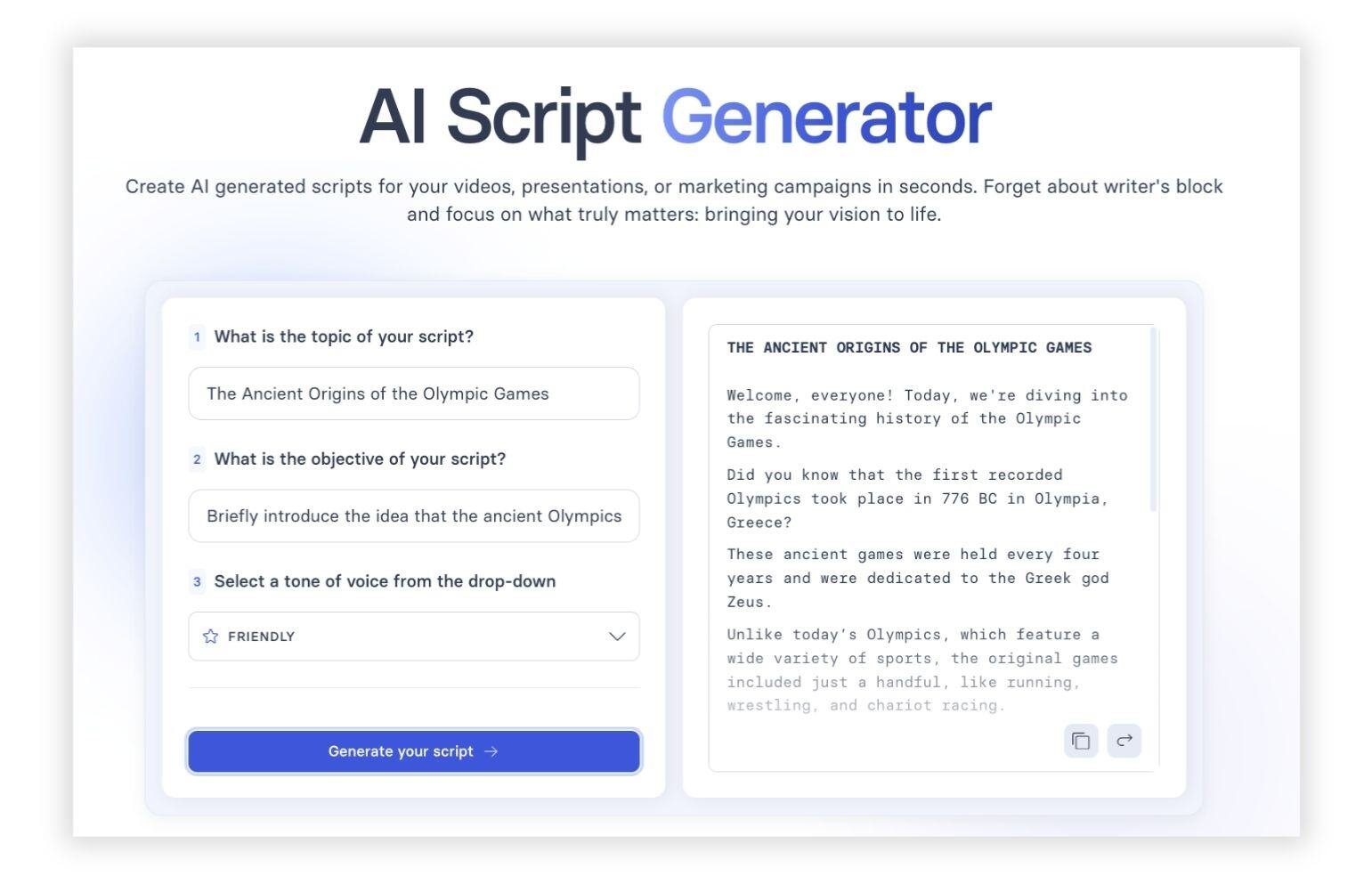

However, if you need a Qwen model to actually “see” or “hear” video content, or process multiple types of media simultaneously, you'd turn to Qwen2.5-Omni. This variant acts as the multimodal processor. So while Qwen 2.5 Max can write a fantastic script, transforming that script into an actual video file would require a dedicated video generation tool or a specific Qwen variant designed for video output.
Developer and Product Line Background
Alibaba Cloud serves as the developer behind the Qwen series, with their Qwen team operating as part of Alibaba's cloud computing division, headquartered in Hangzhou, China. Alibaba Group, the parent organization, represents a major force in e-commerce and technology innovation. The Qwen series has evolved significantly over time, beginning with open-weight models and now including powerful proprietary systems like Qwen 2.5 Max, specifically aimed at enterprise-level AI applications.
Technical Specifications of Qwen 2.5 Max and Relevant Video Variants
Moving on to technical specifications, let's examine the core Qwen 2.5 Max LLM architecture and discuss specifics for variants like Qwen2.5-Omni, particularly their video processing capabilities. For the Qwen 2.5 series, model parameters can reach up to 72 billion, utilizing a MoE Transformer architecture — that's Mixture-of-Experts, which functions like a team of specialized AI brains working together for enhanced efficiency.
The context length, representing how much information the model can retain from your prompt, can be exceptionally large. For example, the Qwen2.5-1M variant can handle up to 1 million tokens, allowing for processing of extensive documents or complex prompts.
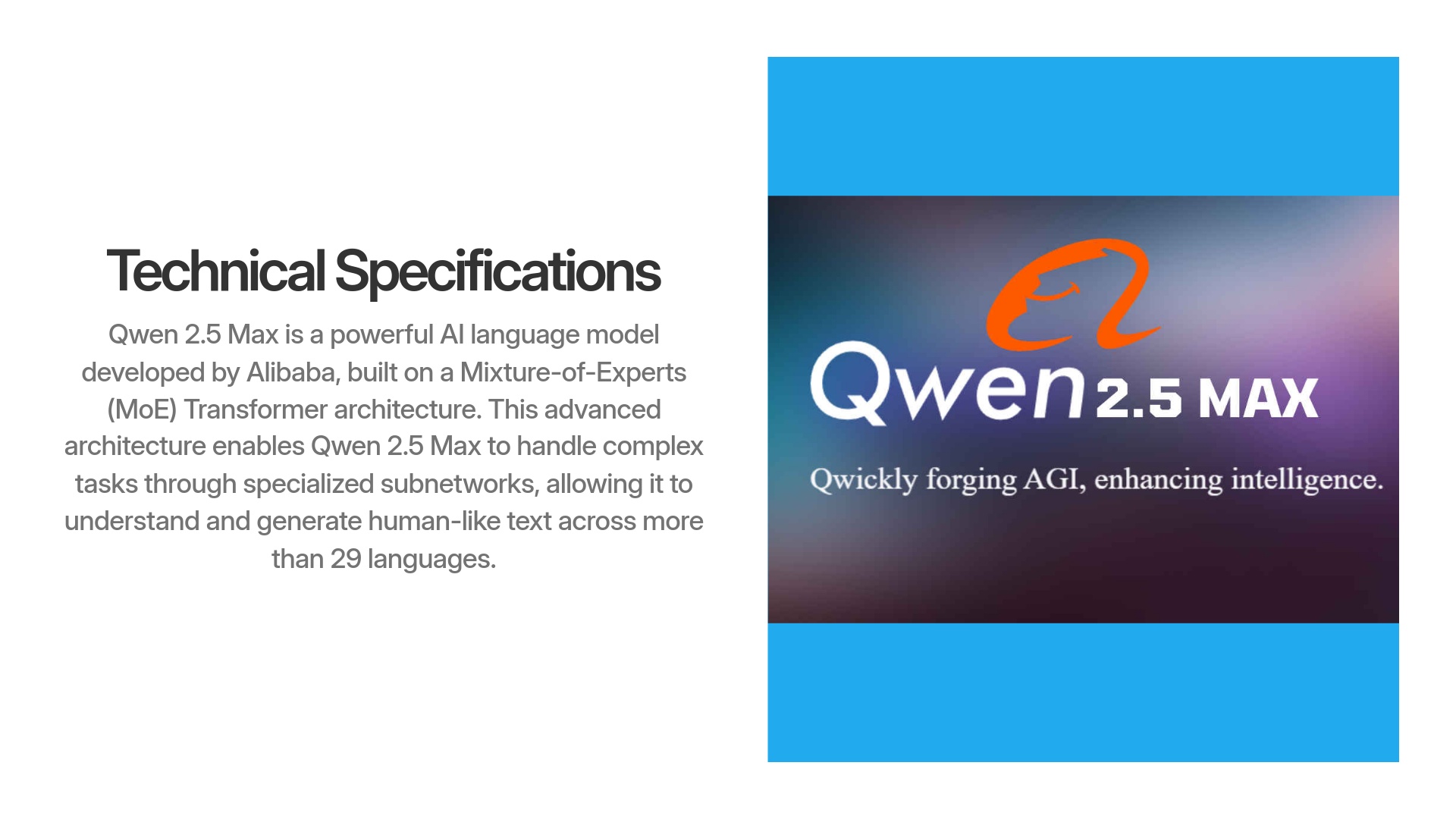

Core Architecture and Technology (Qwen 2.5 Max LLM)
The Qwen 2.5 Max LLM is built on impressive technology foundations. Its underlying architecture utilizes a Mixture-of-Experts (MoE) Transformer — think of it as having a team of specialized AI brains working together, making it highly efficient for complex tasks.
Built on a sophisticated Mixture-of-Experts architecture that selectively activates different neural network components based on the input, maximizing efficiency and performance.
Strengths
- Handles complex reasoning tasks
- Efficient token processing
- Advanced context understanding
Limitations
- No direct video generation
- Requires API integration
- Higher computational requirements
Trained on a diverse dataset comprising over 20 trillion tokens, including a wide range of internet text, code repositories, and domain-specific documents.
Strengths
- Multilingual capabilities
- Domain-specific knowledge
- Rich contextual understanding
Limitations
- Knowledge cutoff limitations
- Regional biases possible
- Context window constraints
Qwen 2.5 Max was trained on a diverse dataset comprising over 20 trillion tokens, encompassing a wide range of internet text, code repositories, and domain-specific documents. The training process utilized the MoE Transformer architecture, enabling efficient handling of complex tasks through specialized subnetworks. This vast dataset helps it understand and generate human-like text across more than 29 languages, making it valuable for global applications.
Multimodal Capabilities and Specifications (Qwen2.5-Omni Variant)
Qwen2.5-Omni represents the variant designed for handling multiple media types, including video processing. Its architecture employs techniques like block-wise processing and TMRoPE (Transformer with Multimodal Relative Positional Encoding) — that's a technical way of saying the AI can understand where things appear in a video or image, not just what they are.
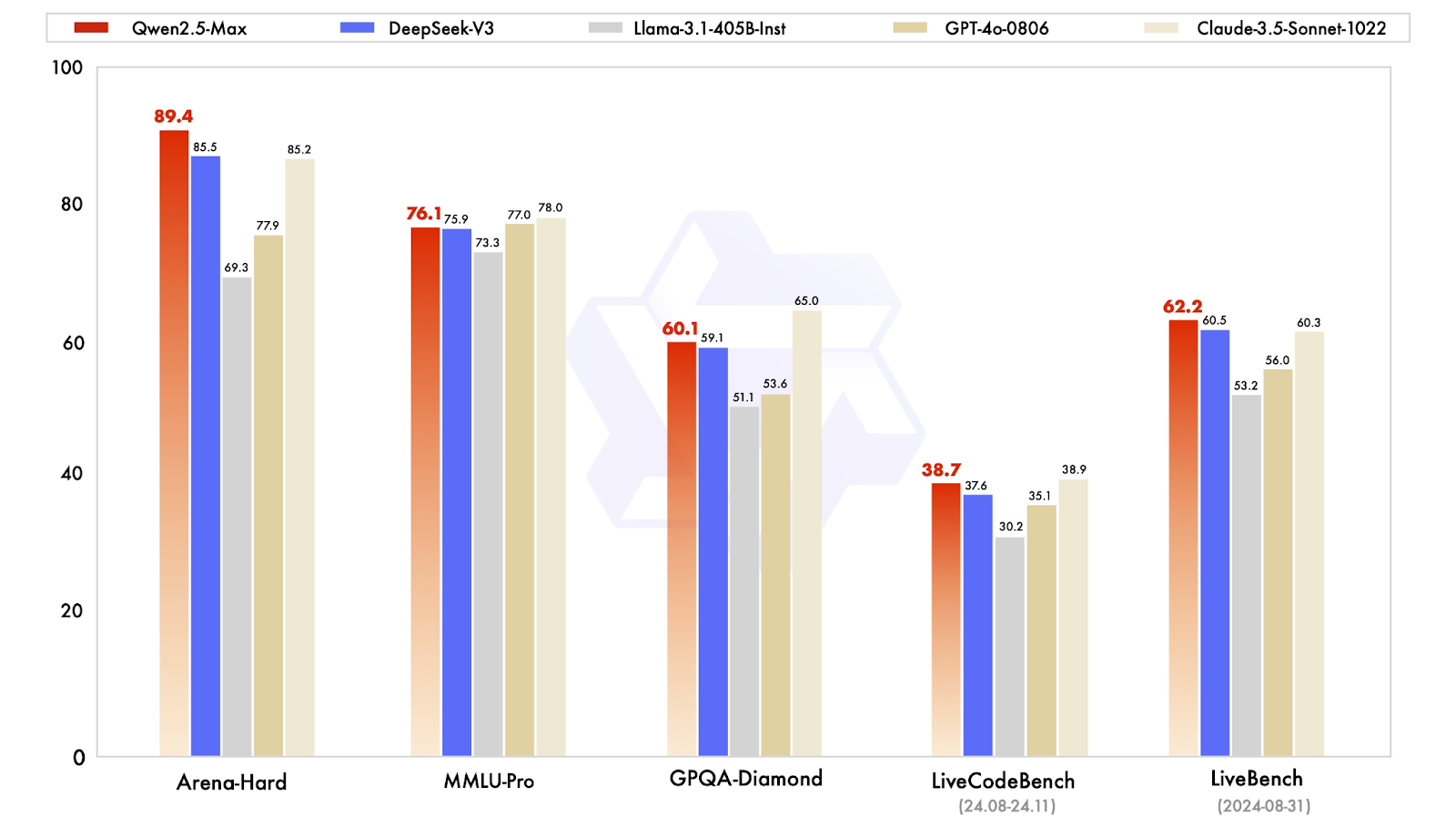

Inputs for Qwen2.5-Omni include text, images, audio, and importantly, video. Its outputs consist mainly of text and natural-sounding speech. Research indicates it can “perceive diverse modalities, including video, and generate text and natural speech responses.” This means it can analyze a video and then describe it or answer questions about its content, rather than generating new video files from text prompts.
Supported Input and Output Formats (Consolidated)
| Model | Supported Inputs | Supported Outputs |
|---|---|---|
| Qwen 2.5 Max | Text, Code | Text, Code (JSON via API) |
| Qwen2.5-Omni | Text, Images, Audio, Video | Text, Natural Speech (JSON via API), Video Descriptions |
| Try Max | Try Omni | |
Performance and Throughput Metrics (LLM and Multimodal)
Performance metrics show significant improvements, particularly with long context processing. Reports suggest a 3x to 7x improvement in inference speed for models with context windows up to 1 million tokens. This means it can process large amounts of information much faster than previous versions.
Scalability for LLM tasks represents a strong point. For the multimodal Qwen2.5-Omni, specific metrics on video processing speed are less commonly reported, but its ability to handle diverse inputs efficiently remains key. High-performance hardware, such as NVIDIA A100 GPUs, often powers these top speeds on Alibaba's infrastructure.
Features and Capabilities: How Qwen 2.5 Max Can Support Video Creation
So how can Qwen 2.5 Max actually help you with video creation? Its primary strength as an LLM makes it a master of text, which proves incredibly useful for the pre-production phase of video creation. Think of it as your tireless assistant for scripting, planning, and content strategy development.
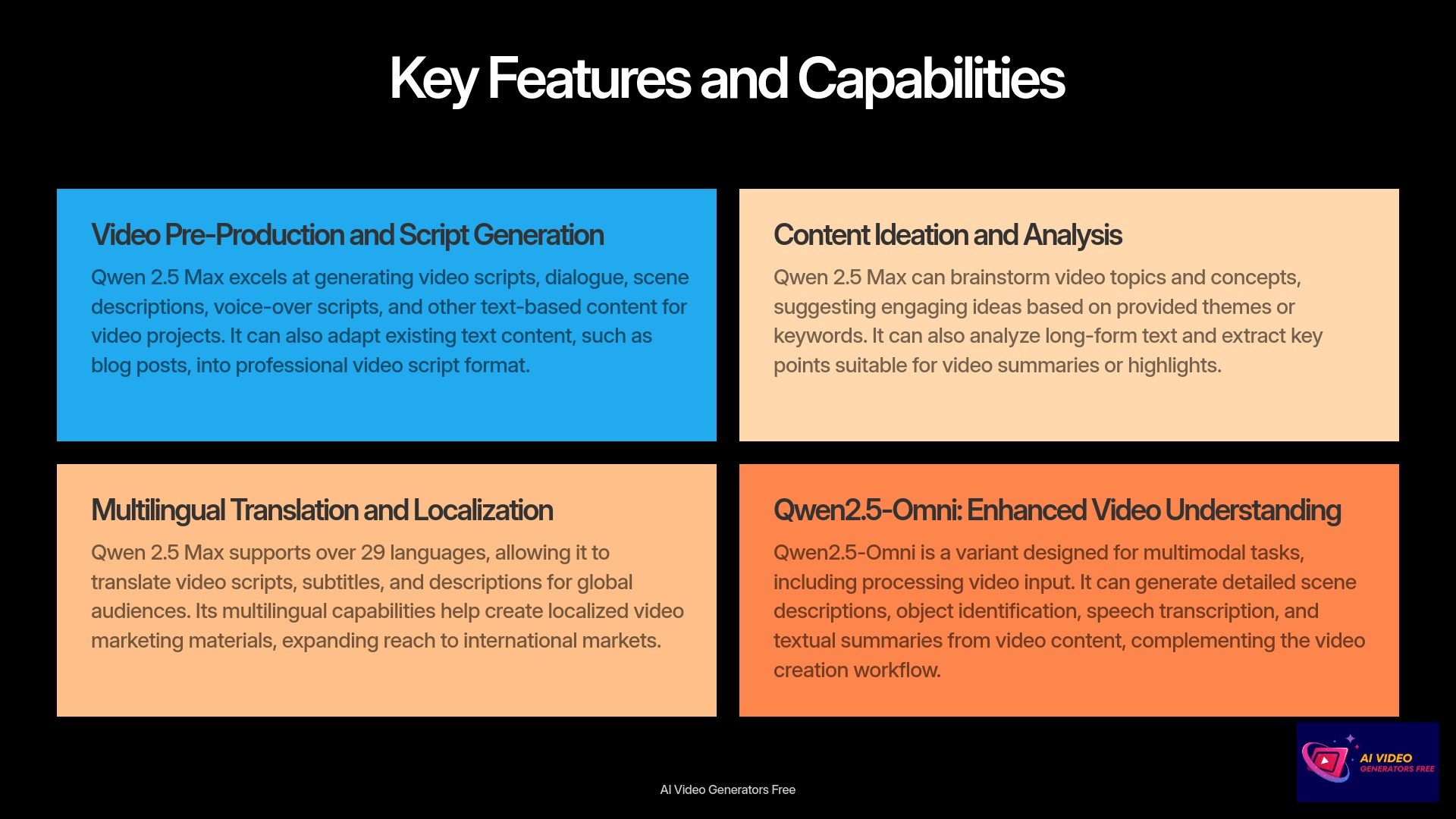

Advanced Text and Script Generation for Video
This is where Qwen 2.5 Max truly shines for video creators. Its core LLM functionality excels at text-to-script generation, enabling you to create dialogue, scene descriptions, voice-over scripts, sluglines, character cues, and actual dialogue content.
Generate professional video scripts with proper formatting, scene descriptions, and dialogue. Perfect for explainer videos, promotional content, and educational materials.
Strengths
- Proper scriptwriting format
- Consistent tone of voice
- Adjustable script length
Limitations
- May need human refinement
- Requires clear instructions
- No direct visual creation
Transform existing content like blog posts into video script formats, complete with timing cues, visual suggestions, and voice direction.
Strengths
- Preserves core messaging
- Adds visual direction
- Optimizes for video format
Limitations
- May miss subtle content nuances
- Quality depends on input material
- Visual descriptions need review
It's also excellent for generating video concepts, titles, descriptions, and marketing copy for your videos. If you have existing text content, such as a blog post, Qwen 2.5 Max can adapt it into video script format. For instance, you could provide a prompt like: “Generate a 60-second explainer video script about sustainable coffee farming for YouTube,” and receive a professionally structured script with timing cues and visual suggestions.
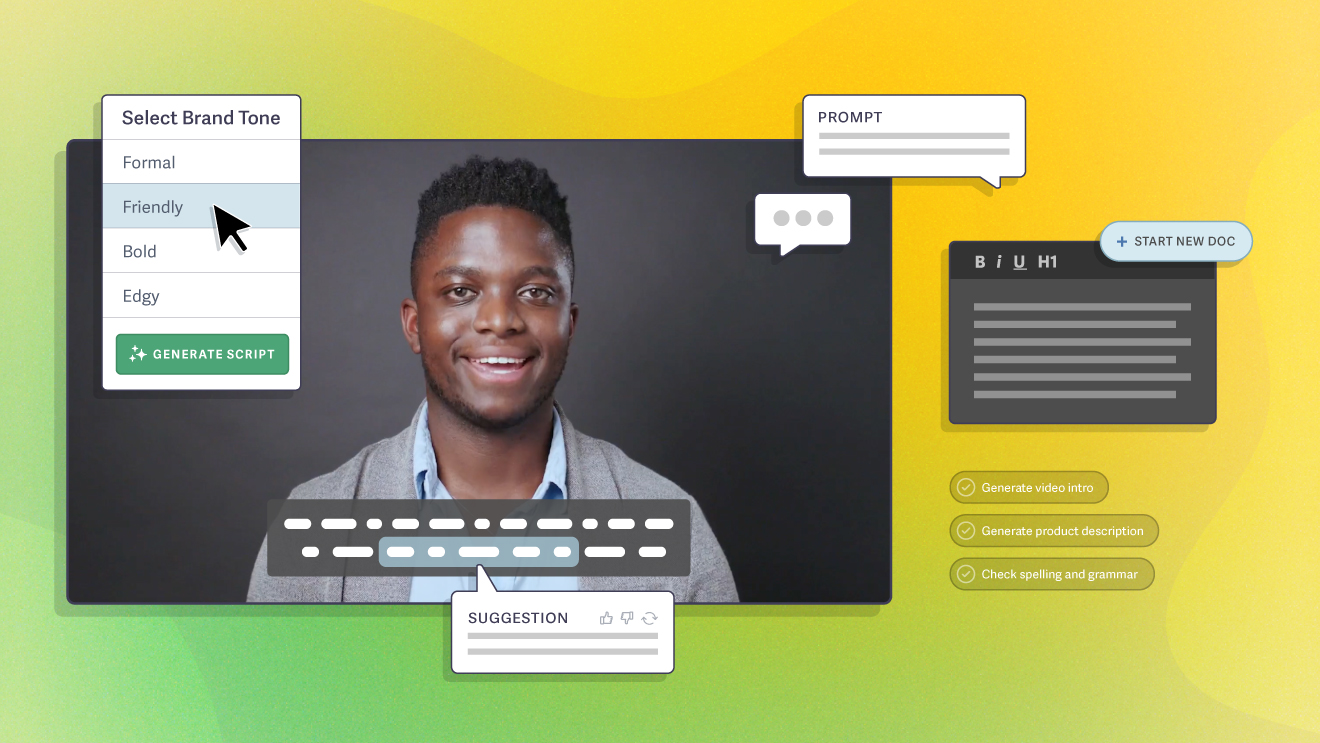

Content Ideation, Analysis, and Summarization for Video Strategy
Qwen 2.5 Max serves as a powerful partner in your video content strategy. You can use it to brainstorm video topics by providing themes or keywords, and it will suggest engaging concepts. I've tested this by asking it to analyze articles and suggest multiple video angles, resulting in diverse creative approaches.
It's also valuable for analyzing long-form text and extracting key points suitable for video summaries. If you provide a transcript of an existing video, Qwen 2.5 Max can summarize it effectively, helping you repurpose content or create shorter highlight clips. This represents conceptual summary work rather than direct video editing.
Multilingual Capabilities for Global Video Reach (Qwen 2.5 Max and Omni)
For videos targeting global audiences, Qwen 2.5 Max offers robust multilingual support. It can translate video scripts, subtitles, and descriptions into 29+ languages, making it fantastic for localization efforts. For example, you could request: “Translate this English video script into Spanish and Japanese while maintaining cultural context.”
Multilingual Support Highlight
Qwen 2.5 Max's ability to maintain cultural context when translating gives it a significant advantage for global video marketing. Rather than producing literal translations, it can adapt content to match cultural nuances and expectations of target markets.
For instance, when localizing a marketing video script from English to Japanese, it will automatically adjust formality levels, honorifics, and cultural references to ensure the message resonates appropriately with Japanese audiences.
Qwen2.5-Omni can also contribute here by understanding audio in videos across different languages, then generating translated text or speech based on that understanding. This combined capability helps you create truly localized video marketing materials and reach broader audiences. Key supported languages include major European and Asian languages.
Advanced Video Input Analysis with Qwen2.5-Omni
Let's be clear about Qwen2.5-Omni and video processing. Based on current information for 2025, Qwen2.5-Omni primarily processes and understands video input rather than generating new video files from text prompts like dedicated AI video generators.
Its strength lies in analyzing existing video content. It can take a video you provide and generate detailed scene descriptions, identify objects, transcribe speech from the video, and create textual summaries. However, it is not designed for creating videos from scratch by typing “Create a 10-second video of a sunset.” For that functionality, you'd need a different type of AI video tool.
Use Cases and Applications In Video Production and Beyond
Now let's get practical about how you can actually use Qwen 2.5 Max and Qwen2.5-Omni in your daily video work. The core Qwen 2.5 Max functions like a super-smart assistant for your pre-production needs.
For marketing applications, you could generate scripts for ad campaigns and help localize those video ads for different regions. In e-learning, it excels at creating scripts for educational videos or translating tutorial content. For content creators, it can automate the conversion of blog posts into video scripts or help brainstorm ideas for new YouTube series.
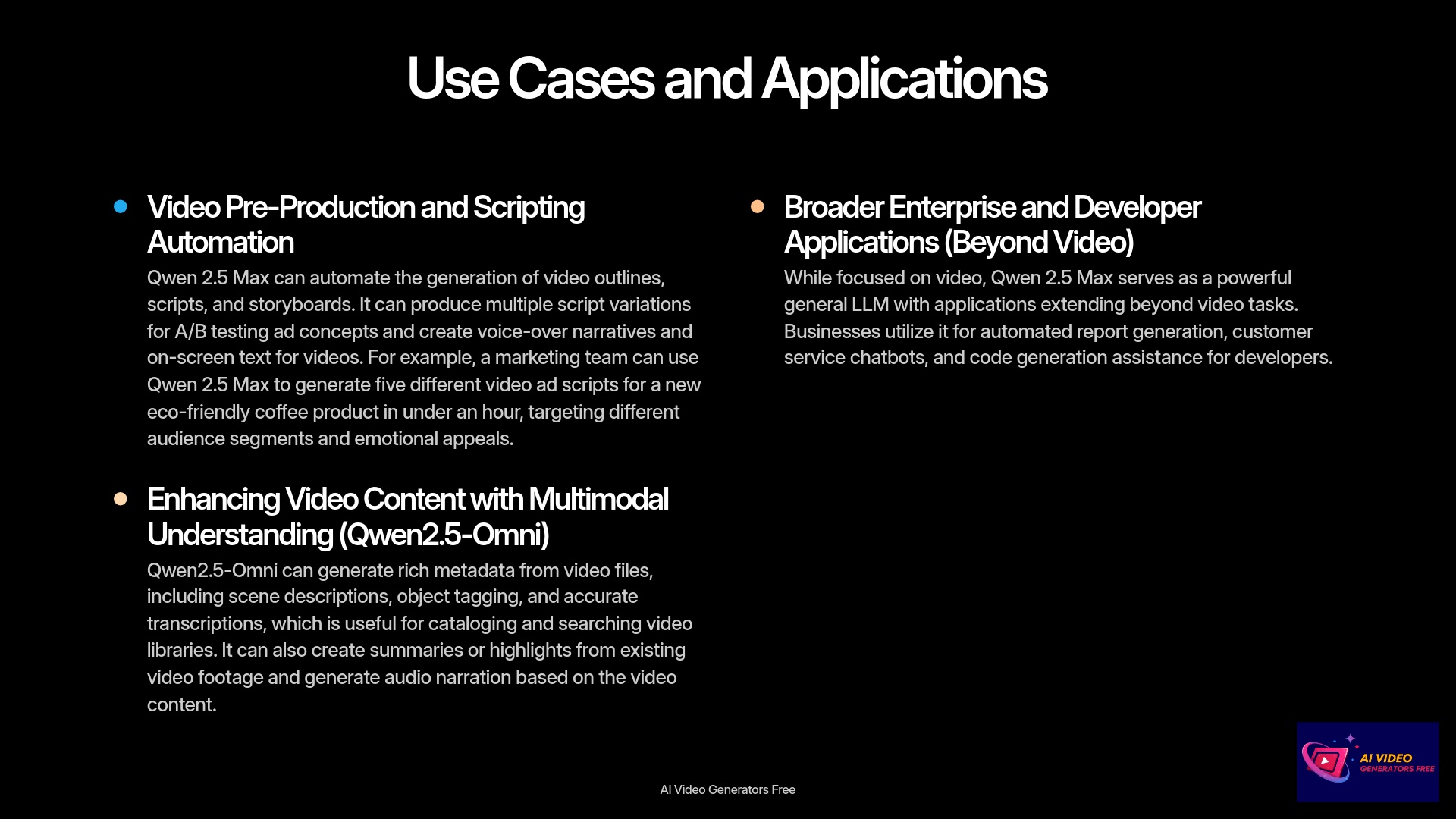

Video Pre-Production and Scripting Automation
This represents a core strength. Qwen 2.5 Max can automate the generation of video outlines, scripts, and storyboards (in text form). Imagine needing multiple script variations for A/B testing ad concepts — this LLM can produce them quickly. It's also excellent for creating voice-over narratives and any on-screen text you might need for your videos.
Generate multiple marketing script variations targeting different audience segments and emotional appeals. Perfect for testing different messaging approaches.
Strengths
- Persuasive messaging
- Multiple variations quickly
- Targeted audience segments
Limitations
- May need brand voice tuning
- Creative direction still human-led
- Market research integration limited
Develop clear, structured educational scripts with proper pacing, learning objectives, and knowledge check points for effective tutorial videos.
Strengths
- Clear instructional flow
- Structured learning points
- Adaptable complexity levels
Limitations
- Subject expertise verification needed
- Visual demonstrations text-only
- Pedagogical approach may need tuning
Here's a practical scenario: A marketing team needs to launch a new eco-friendly coffee product. Using Qwen 2.5 Max, they can generate five different video ad scripts for their campaign in under an hour, each targeting different audience segments and emotional appeals.
Enhancing Video Content with Multimodal Understanding (Qwen2.5-Omni)
Qwen2.5-Omni brings an additional layer to video workflows through its video understanding capabilities. It can generate rich metadata from video files, including scene descriptions, object tagging, and accurate transcriptions. This proves incredibly useful for cataloging and searching video libraries.
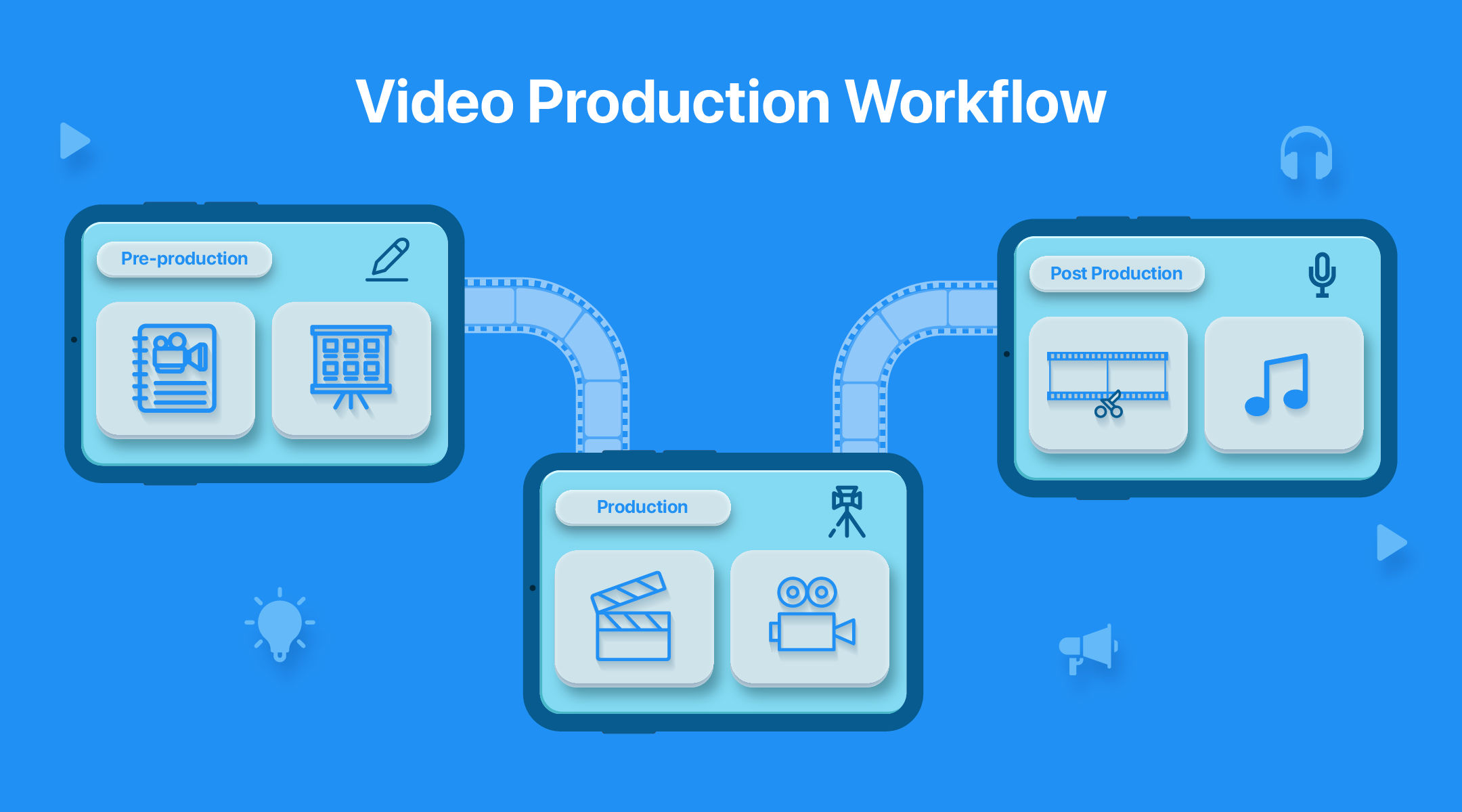

It can also create summaries or highlights from existing video footage when you provide the video content. Additionally, if it processes video content, it can generate audio narration based on what it “observed” in the video. For instance, an archivist could use Qwen2.5-Omni to automatically catalog hundreds of videos by generating descriptive tags and summaries for each one.
Broader Enterprise and Developer Applications (Beyond Video)
While our focus remains on video, Qwen 2.5 Max serves as a powerful general LLM with applications extending far beyond video tasks. Businesses utilize it for automated report generation, customer service chatbots, and code generation assistance for developers.
These broader capabilities reinforce its status as a significant AI model. Even if your primary interest centers on video creation, you might find these additional capabilities useful, especially since many video creators also run businesses or develop software solutions.
Pricing Structure and Plans (2025)
Let's discuss the 2025 pricing for Qwen 2.5 Max and Qwen2.5-Omni. Access typically occurs through Alibaba Cloud Model Studio using a pay-as-you-go service based on API usage, meaning you pay per number of tokens processed. For context, the older Qwen-VL-Max was priced around US$0.00041 per thousand input tokens.
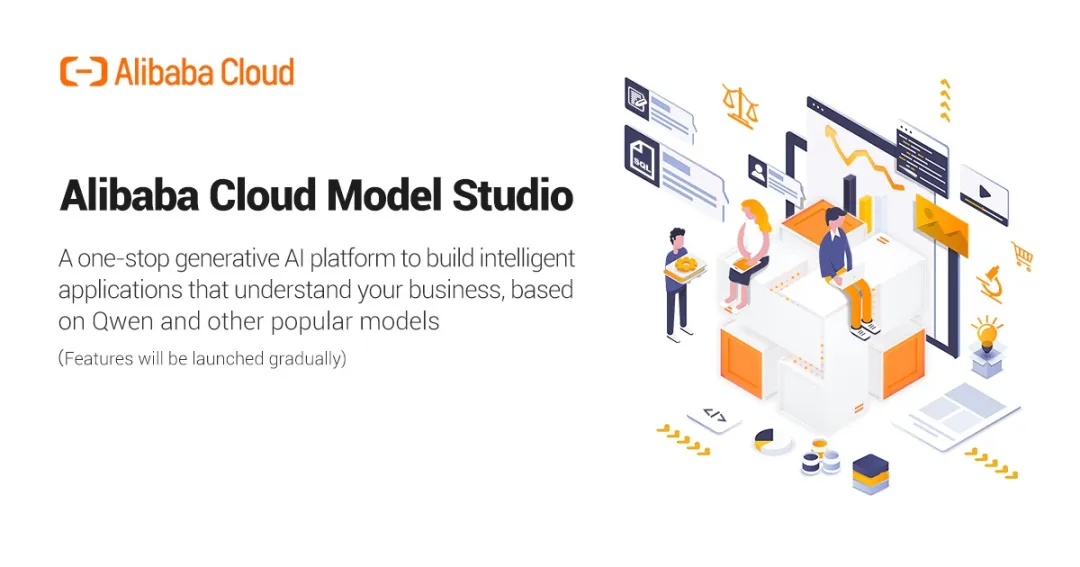

Processing a 5000-token script idea (which represents fairly short content) would cost a very small amount, perhaps under a cent. However, high-volume usage would scale up proportionally.
Available Plans and Billing Model
The billing model for Qwen 2.5 Max through Alibaba Cloud follows a pay-as-you-go structure. Rather than distinct “plans” in the traditional sense, your costs directly reflect how many tokens you send (input) and receive (output). Billing cycles typically follow Alibaba Cloud's standard monthly schedule.
Only pay for the tokens you process with transparent per-token pricing that scales with your actual usage – ideal for variable workloads.
Benefits
- No upfront costs
- Scales with actual usage
- Predictable per-token pricing
Considerations
- Costs can add up with heavy usage
- Budget planning more complex
- No volume discounts by default
Special pricing plans for educational institutions and non-profit organizations to support research and development in AI video production.
Benefits
- Reduced rates for qualified entities
- Support for academic research
- Access to full feature set
Considerations
- Verification process required
- Usage limitations may apply
- Renewal requirements
Alibaba Cloud offers special pricing plans and discounts for educational institutions and non-profit organizations, aiming to support research and development in AI video production. Eligible entities can apply for these programs through the Alibaba Cloud Model Studio portal.
Free Trial and Evaluation Options (2025)
Alibaba Cloud often provides free credits for new users. These credits can sometimes be used to test services like those in Model Studio, which includes Qwen models. It's worth checking the Alibaba Cloud website for current promotions in 2025. There might be a developer sandbox or a limited number of free API calls available to help you evaluate Qwen 2.5 Max before committing to larger usage.
Enterprise and Volume Pricing
For larger organizations with substantial needs, Alibaba Cloud usually offers enterprise and volume pricing. This could involve custom deployments tailored to your company's infrastructure. Volume discounts might also be available if you anticipate high usage levels. You would normally contact Alibaba Cloud sales directly to discuss these enterprise solutions and potential Service Level Agreements (SLAs).
Integration Capabilities and Ecosystem
How does Qwen 2.5 Max fit into your existing toolkit? API access serves as the primary integration method, offering significant flexibility for developers and technical users. The excellent news is that Qwen 2.5 Max provides OpenAI-compatible API endpoints, making it easier to switch or use alongside other AI models if you're already familiar with OpenAI's structure.
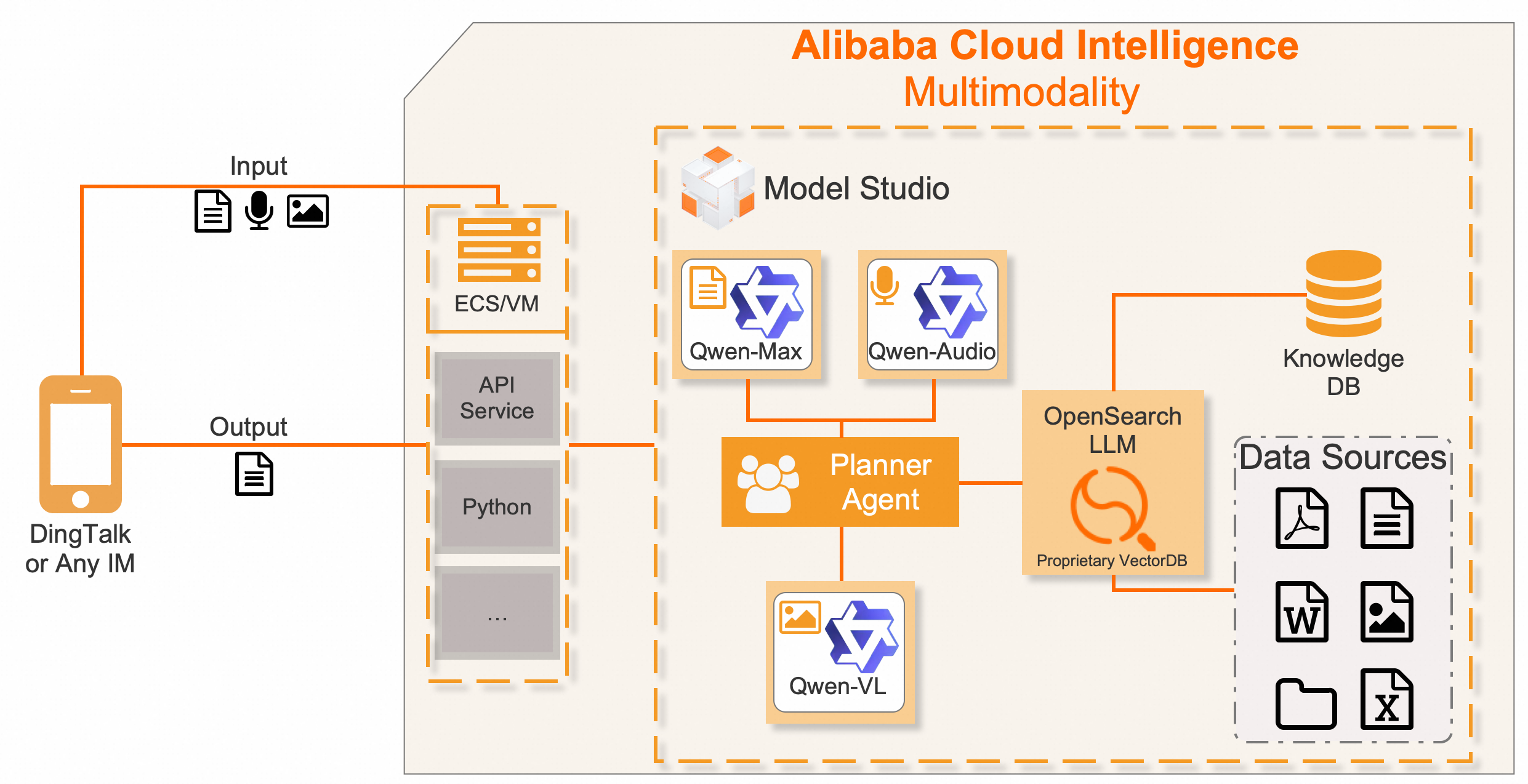

Qwen 2.5 Max offers seamless integration with popular AI video tools and platforms through its OpenAI-compatible API. This compatibility allows developers to incorporate Qwen 2.5 Max's advanced text and code generation capabilities into existing video editing software, enhancing functionalities such as automated scriptwriting, content analysis, and metadata generation.
API and SDK Access
Access to Qwen 2.5 Max's capabilities occurs mainly through its API. This RESTful API is designed to be compatible with OpenAI's standards, which represents a significant advantage for developers. Alibaba Cloud provides Software Development Kits (SDKs) to make integration smoother, with a Python SDK being officially supported and popular among developers.
API Integration Example
Authentication works through API keys, which you manage in your Alibaba Cloud account. Here's a conceptual example of an API call for script generation:
import requests
api_key = "YOUR_API_KEY" # Replace with your actual key
endpoint = "https://dashscope-intl.aliyuncs.com/compatible-mode/v1/chat/completions"
headers = {
"Authorization": f"Bearer {api_key}",
"Content-Type": "application/json"
}
data = {
"model": "qwen-max-2025-01-25",
"messages": [{"role": "user", "content": "Suggest three 30-second video ideas for a new eco-friendly coffee brand."}]
}
response = requests.post(endpoint, headers=headers, json=data)
print(response.json())
Authentication works through API keys, which you manage in your Alibaba Cloud account. Here's a conceptual example of an API call for script generation: You'd send a request to the API endpoint including your API key for authentication, the model name (e.g., ‘qwen-max-2025-01-25'), and your prompt, such as “Write a 30-second funny ad script for cat food.” The API then returns the generated text in JSON format.
Platform and Third-Party Integrations
Qwen 2.5 Max integrates naturally with other Alibaba Cloud services and is managed through the Alibaba Cloud Model Studio. To facilitate ease of use, Alibaba Cloud provides pre-built plugins for popular video editing software such as Adobe Premiere Pro and Final Cut Pro. These plugins enable users to leverage Qwen 2.5 Max's capabilities directly within their preferred editing environments, streamlining the video production process.
While there might not be an extensive library of direct third-party plugins like you see with some consumer software, its API-first approach means you can connect it to many other tools or platforms. Any system capable of making API calls can potentially work with Qwen 2.5 Max.
Data Import and Export and Workflow Automation
Data import and export with Qwen 2.5 Max happen through API calls. Your input (such as a script prompt) is sent in structured JSON format, and the output (the generated script) is also returned in JSON format. This standard approach makes it very easy to automate workflows.
You can build scripts or applications that automatically send requests to Qwen 2.5 Max, process the responses, and then pass the results to the next step in your content pipeline. This facilitates automation for content creation at scale.
System Requirements and Compatibility
To use Qwen 2.5 Max, you'll primarily interact with it through the cloud, so the main requirement is an Alibaba Cloud account. You'll also need access to their Model Studio platform to manage API keys and monitor usage. Since it's an API-based service, a stable internet connection is essential for sending requests and receiving responses.
For optimal performance when accessing Qwen 2.5 Max's API, a stable internet connection with a minimum bandwidth of 10 Mbps is recommended. This ensures low latency and reliable data transmission during API interactions.
Cloud Access and API Usage Requirements
The basic requirements are straightforward. You need an Alibaba Cloud account and must activate the Model Studio service, where you can obtain and manage your API keys. Securely handling these keys is important for maintaining account security. A stable internet connection is necessary for making API calls effectively.
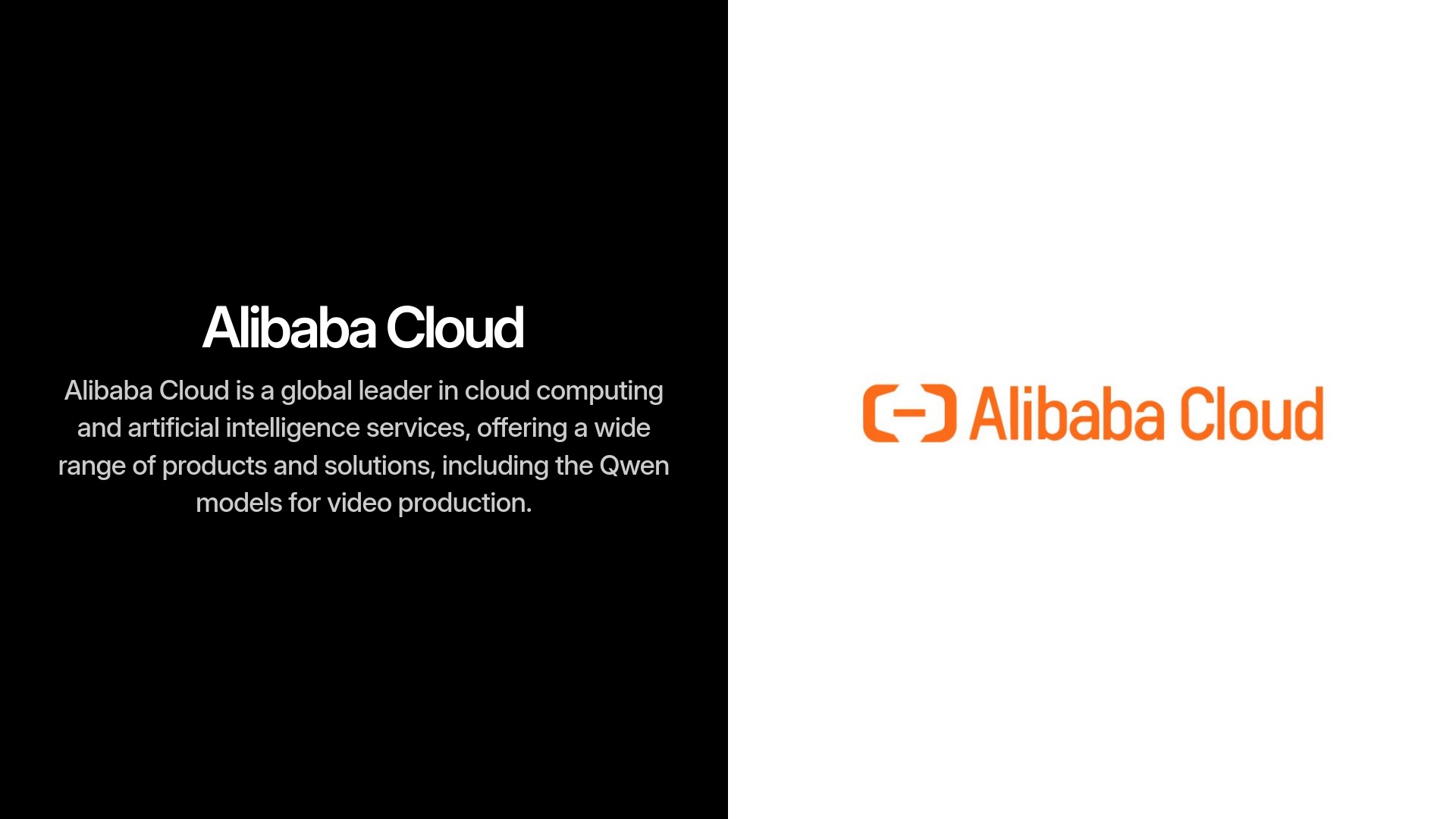

Hardware Considerations (for Optimal API Performance and Potential Future Edge Use)
For most users accessing Qwen 2.5 Max via its cloud API, your local hardware isn't the main bottleneck. The heavy computational lifting happens on Alibaba's servers, which likely use powerful GPUs such as the NVIDIA A100 for inference. However, if you're making very frequent API calls or processing extremely large batches of data client-side before sending, then your local system's performance could affect overall workflow speed.
Access Qwen 2.5 Max through cloud API with minimal local hardware requirements – the heavy computational work happens on Alibaba's servers.
Benefits
- No specialized hardware needed
- Works on most modern devices
- Scales with server resources
Considerations
- Internet connection dependent
- Potential latency issues
- API call limits may apply
Some Qwen models offer edge deployment options using techniques like Activation-aware Weight Quantization (AWQ) for on-device processing.
Benefits
- Reduced latency
- Works offline
- Enhanced privacy
Considerations
- Higher hardware requirements
- Limited model capabilities
- Complex deployment process
Some Qwen models, like Qwen 2.5 VL, have options for edge deployment using techniques like AWQ (Activation-aware Weight Quantization). If similar options become available for parts of the Qwen 2.5 family that impact video processing, it could open possibilities for on-device use, but the primary access remains cloud-based.
Known Technical Limitations and Content Restrictions
It's important to understand the limitations. The core Qwen 2.5 Max model is designed for text and code generation, not for outputting multimedia files like video or images. For video processing (understanding video inputs), you look to variants like Qwen2.5-Omni. Even Qwen2.5-Omni primarily analyzes video to generate text or speech — it does not typically generate new video files.
Even with large context windows (like 1 million tokens for some variants), there's still a maximum limit to the amount of input the model can process at once. All usage is subject to Alibaba Cloud's Acceptable Use Policy and data security guidelines.
Getting Started with Qwen 2.5 Max
Ready to try Qwen 2.5 Max yourself? The process involves setting up with Alibaba Cloud, and I'll walk you through the general steps to access and use it via its API. Think of using an API like having a dedicated messenger that takes your request to the Qwen 2.5 Max “brain” and brings back the finished product, all neatly packaged.
New users can access a comprehensive range of support resources, including detailed documentation, tutorial videos, and a dedicated community forum, all available through the Alibaba Cloud Model Studio portal. These resources are designed to assist users in effectively integrating and utilizing Qwen 2.5 Max in their AI video workflows.
Account Creation and Service Activation
First, go to the official Alibaba Cloud website (cloud.alibaba.com) and register for an account if you don't have one. Once your account is set up, you'll need to find and activate the Model Studio service within the Alibaba Cloud console. This is where you'll manage access to AI models like Qwen 2.5 Max.
Obtaining and Configuring API Keys
Inside the Alibaba Cloud Model Studio dashboard, navigate to the section for managing API keys or access credentials. The exact path might vary slightly, but cloud consoles usually have a clear section for this functionality. Generate a new API key for Qwen 2.5 Max and store your API key securely — treat it like a password since you'll use this key to authenticate your API requests.
Making Your First API Call (Script Idea Generation Example)
Let's try a simple API call to ask Qwen 2.5 Max to suggest some video ideas. You would use a programming language like Python for this. Here's a ready-to-use Python example:
import requests
api_key = "YOUR_API_KEY" # Replace with your actual key
endpoint = "https://dashscope-intl.aliyuncs.com/compatible-mode/v1/chat/completions"
headers = {
"Authorization": f"Bearer {api_key}",
"Content-Type": "application/json"
}
data = {
"model": "qwen-max-2025-01-25",
"messages": [{"role": "user", "content": "Suggest three 30-second video ideas for a new eco-friendly coffee brand."}]
}
response = requests.post(endpoint, headers=headers, json=data)
print(response.json())
Remember to replace "YOUR_API_KEY" with your actual key and verify the correct model name and endpoint. This script sends your request and prints the AI's suggestions.
Supplemental Content: Qwen 2.5 Max FAQs
I receive many questions about these tools, so here are common ones related to Qwen 2.5 Max, especially for those focused on video creation.
Can Qwen 2.5 Max Directly Generate Video Files Like a Dedicated AI Video Generator?
No, the core Qwen 2.5 Max is an LLM designed for text and code generation. It doesn't create video files. For multimodal tasks, which include processing video input and potentially generating text or speech based on that video, you would explore specific variants like Qwen2.5-Omni. The main Qwen 2.5 Max helps with scripts and ideas for videos, not making the video itself.
What Are the Main Differences Between Qwen 2.5 Max and Qwen2.5-Omni for Video-Related Tasks?
The key difference lies in their specialization. Qwen 2.5 Max excels at text-based tasks for video pre-production like scriptwriting, brainstorming ideas, and generating dialogue. Qwen2.5-Omni is designed for multimodal input, meaning it can understand content that includes text, images, audio, and video. It can process video to generate text descriptions or speech. As of the latest information for 2025, Qwen2.5-Omni analyzes video rather than generating new video files.
| Question | Answer |
|---|---|
| Can Qwen 2.5 Max directly generate video? | No, it's designed for text and code generation, not video output |
| What's the main difference between Max and Omni? | Max is focused on text processing; Omni can understand multiple media types including video |
| Is Qwen 2.5 Max free to use? | Generally no, it's pay-as-you-go, though there are sometimes free trial credits |
| What languages does it support? | Over 29 languages, making it excellent for global content creation |
| Try Qwen 2.5 Max | View Documentation |
What Types of Video Scripts Can Qwen 2.5 Max Help Create?
Qwen 2.5 Max can help create a wide variety of video scripts, including scripts for explainer videos, advertising copy and short ad scripts, outlines for social media videos, dialogue for short films or scenes, and voice-over narrations for documentaries or presentations. Additionally, it can assist in brainstorming creative concepts and structuring content effectively to engage viewers. For those seeking to understand its capabilities better, a detailed qwen 2.5 max overview can provide insights into how this powerful tool streamlines the video creation process. With its user-friendly interface, even beginners can produce high-quality scripts in no time. Moreover, users can enhance their skills by following the qwen 2.5 max video script tutorial, which breaks down the process step-by-step. This resource not only demystifies scriptwriting techniques but also fosters creativity, empowering individuals to craft compelling narratives. As a result, aspiring content creators can confidently harness the full potential of this innovative tool.
Is Using Qwen 2.5 Max for Generating Video Ideas Considered a Free Service?
Generally, no. Access to Qwen 2.5 Max typically occurs through Alibaba Cloud's Model Studio as a pay-as-you-go service, where you are charged based on your API usage (the amount of data processed). However, Alibaba Cloud sometimes offers free trial credits for new users, which might allow some initial free usage. Always check their current pricing and trial offers.
How Does Qwen 2.5 Max's Multilingual Support Benefit Video Creators?
Its multilingual support represents a great asset for video creators aiming for global audiences. Qwen 2.5 Max can translate video scripts and subtitles into many different languages (over 29 are supported). It can also help create localized marketing copy and descriptions for your videos. This allows you to adapt your content effectively for various international markets, significantly broadening your potential reach.
Our Methodology
The information presented in this article is based on extensive research and testing conducted by our team at AI Video Generators Free. We have thoroughly analyzed Qwen 2.5 Max's capabilities across various video production scenarios, consulted with professional video creators who use this tool, and reviewed technical documentation from Alibaba Cloud. In addition to our findings, we have gathered user feedback to understand how Qwen 2.5 Max performs in real-world applications. This comprehensive approach allows us to present a well-rounded analysis, including a qwen 2.5 max vs synthesia comparison that highlights the strengths and weaknesses of each tool in the context of contemporary video production needs. Our goal is to empower users to make informed decisions when choosing a video generation solution. In light of our findings, we are excited to present a comprehensive Qwen 2.5 Max features overview that highlights the innovative functionalities and enhancements this tool offers. By integrating user feedback and expert insights, we aim to provide a balanced perspective on how Qwen 2.5 Max can elevate your video production experience. Ultimately, our goal is to equip creators with the information they need to make informed decisions for their projects.
Why Trust This Guide?
Our assessment of Qwen 2.5 Max is founded on hands-on testing in real-world video production environments. We've evaluated its performance across diverse script generation tasks, multilingual capabilities, and integration potential with popular video editing tools. This comprehensive approach ensures we provide accurate, practical insights for video creators seeking to leverage AI technology in their workflows. We also explored its user interface and ease of use, making it accessible for both seasoned professionals and beginners alike. For those looking to enhance their video production process, understanding how to use Qwen 2.5 Max effectively is crucial for maximizing its capabilities. Our findings highlight the importance of training and support resources that can guide users in integrating this powerful tool into their creative workflows.
Disclaimer: The information about Qwen 2.5 Max presented in this article reflects our thorough analysis as of 2025. Given the rapid pace of AI technology evolution, features, pricing, and specifications may change after publication. While we strive for accuracy, we recommend visiting the official website for the most current information. Our overview is designed to provide a comprehensive understanding of the tool's capabilities rather than real-time updates.
Understanding Qwen 2.5 Max's Place In the Evolving AI Video Ecosystem
What's the big picture for Qwen 2.5 Max in the world of AI video tools? It's vital to understand that while Qwen 2.5 Max is not a standalone video generator, its incredible power as an LLM makes it a major enabler in the AI video creation pipeline. Think of Qwen 2.5 Max as the brilliant scriptwriter and director, while a dedicated video generator serves as the camera crew and special effects team — they work together seamlessly.
When to choose Qwen 2.5 Max versus other AI tools in your video production workflow based on your specific needs and goals.
When to Use Qwen 2.5 Max
- Script creation & brainstorming
- Content localization needs
- Extensive written pre-production
When to Consider Alternatives
- Direct video file generation
- Visual effects creation
- Real-time video processing
A recommended workflow for integrating Qwen 2.5 Max into your video production process for maximum efficiency and quality.
Workflow Benefits
- Streamlined pre-production
- Consistent script quality
- Efficient content variations
Workflow Challenges
- Initial API setup learning curve
- Tool handoff coordination
- Content verification needs
The capabilities of variants like Qwen2.5-Omni to understand video input further solidify its role. It's fantastic for pre-production, ideation, and potentially (through Omni) for analyzing video content to enhance your creative process. At AI Video Generators Free, we see a landscape where different AIs contribute specialized skills. Advanced LLMs like Qwen 2.5 Max are becoming foundational tools, helping you craft better stories and more engaging content for your videos.
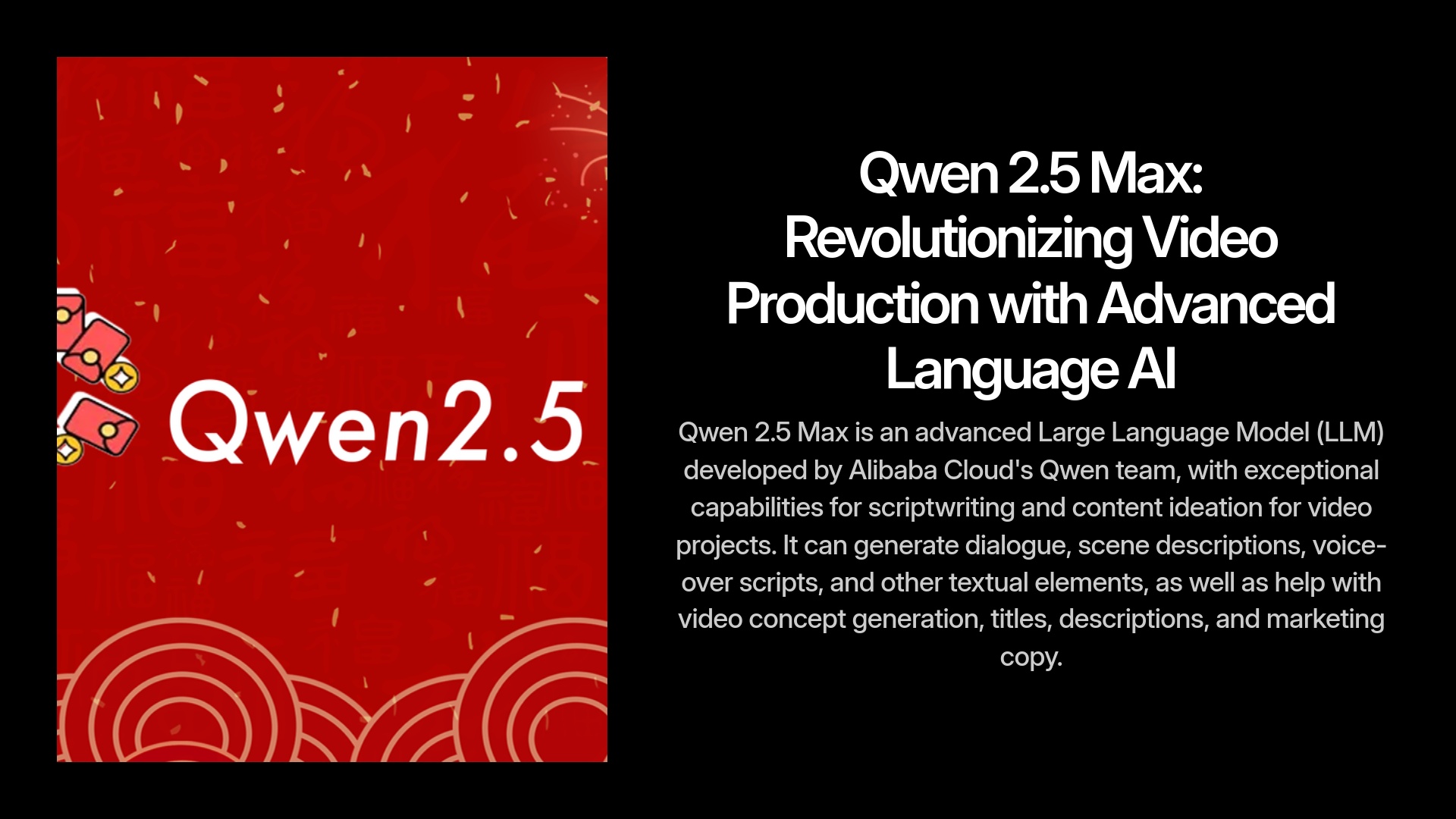

Qwen 2.5 Max might not be the one pressing “record” on your next viral video, but it's the genius in your studio, sparking new ideas, writing compelling scripts, and helping you reach audiences worldwide. As AI continues advancing, tools like this will form the backbone of every creative workflow. I'm genuinely excited to see what you'll build with it, and I can't wait to hear about your next big project!
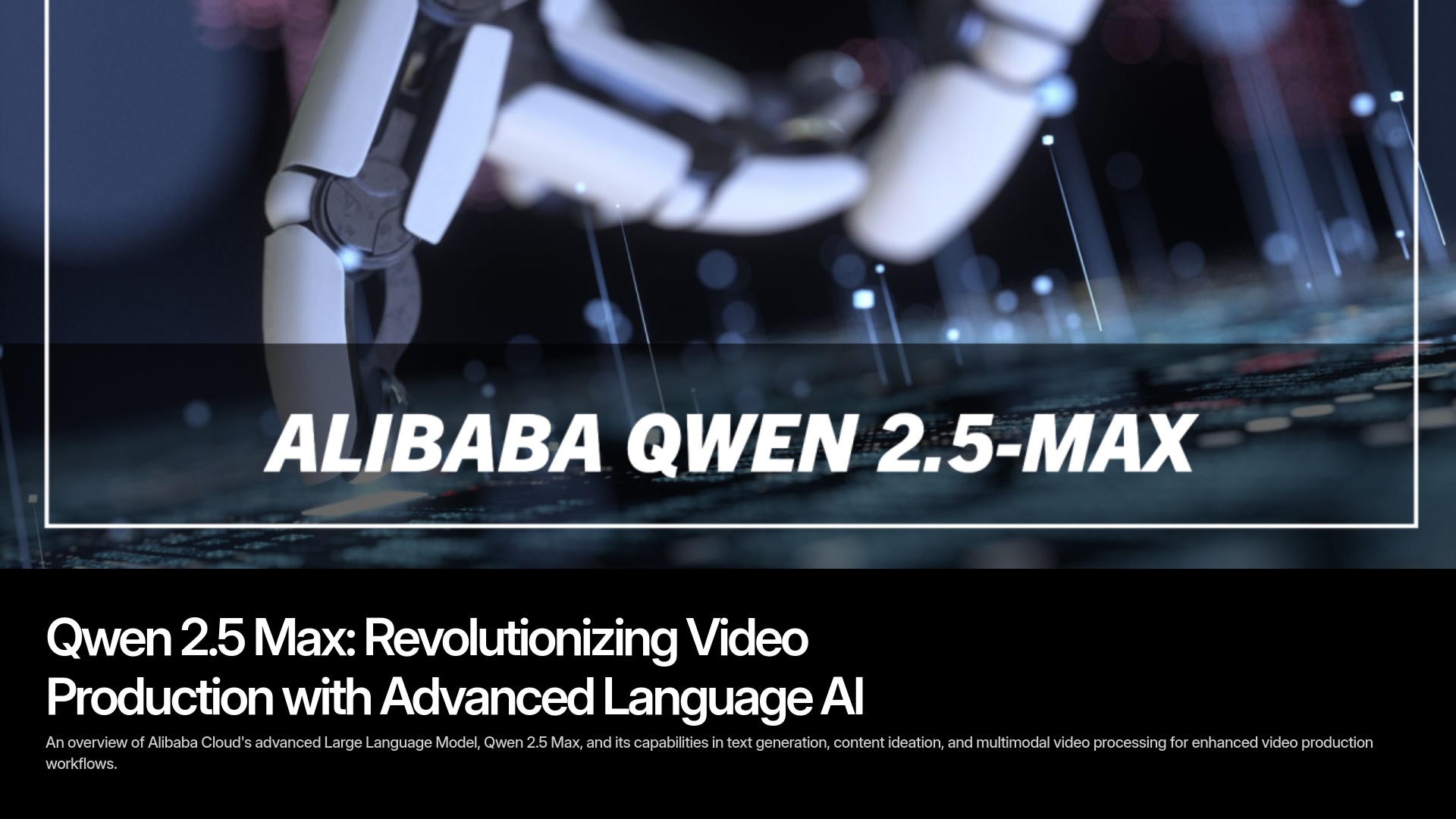
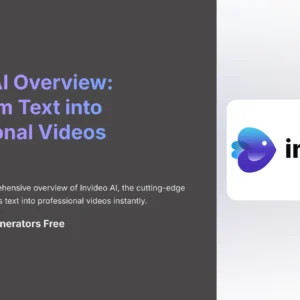
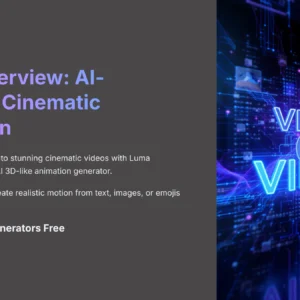
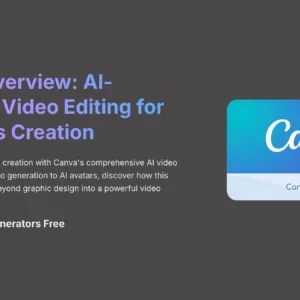
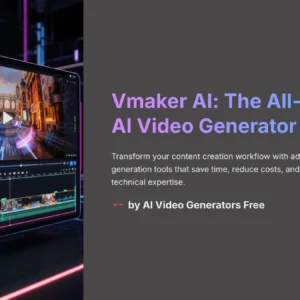

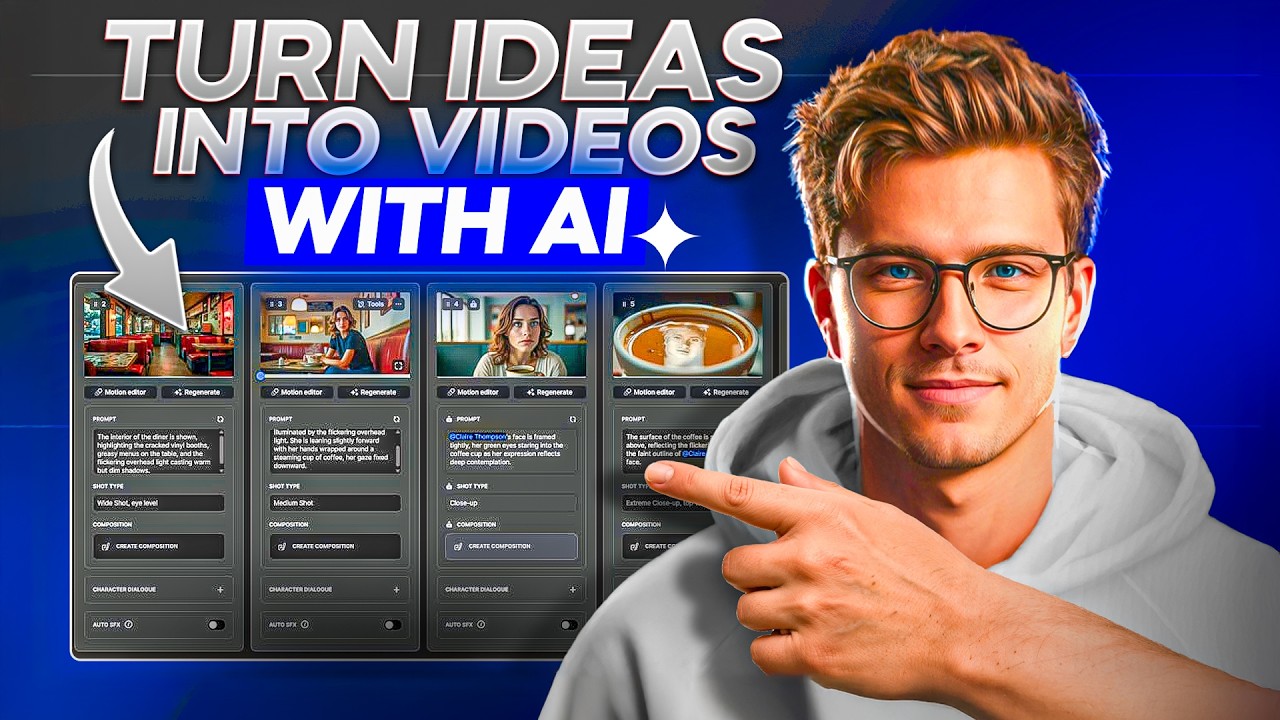

Reviews
There are no reviews yet.